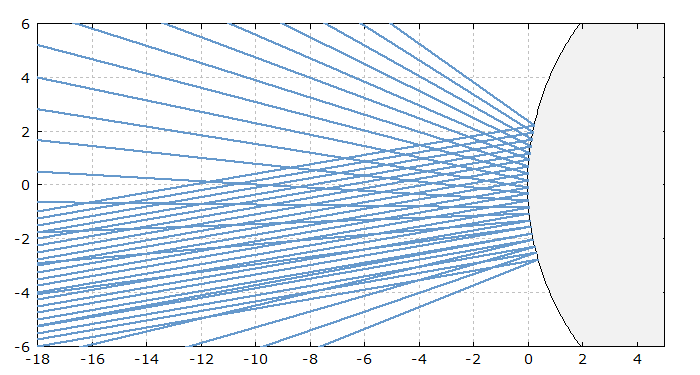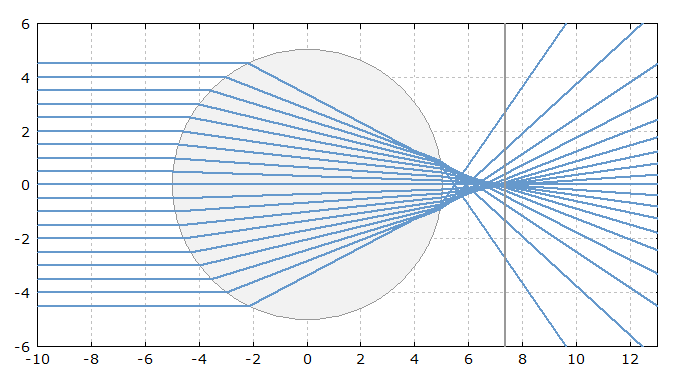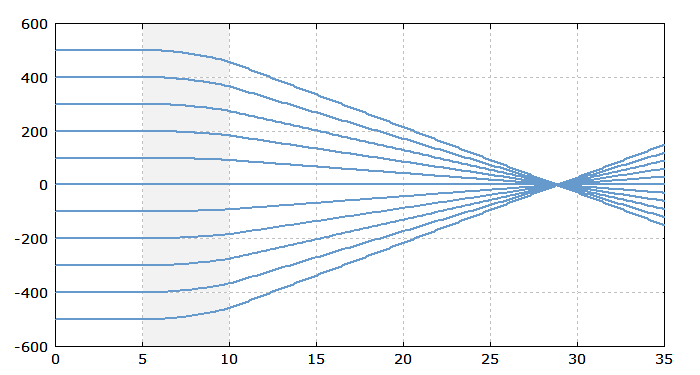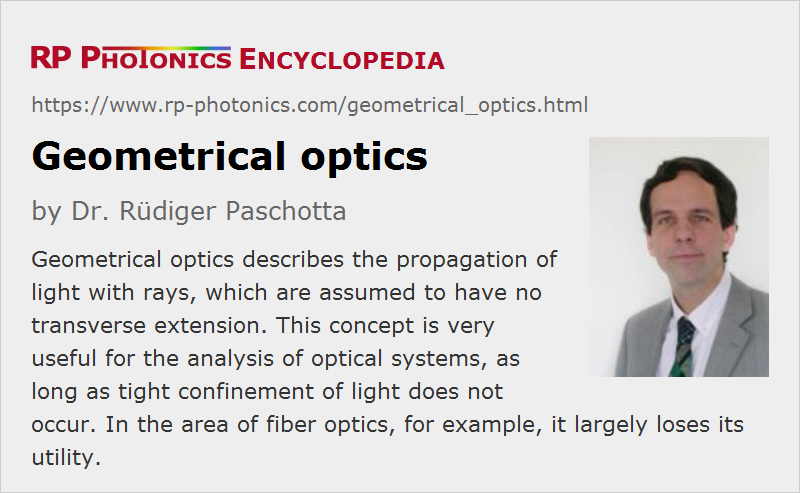Geometrical Optics
Definition: a concept of optics which is based on the propagation of light rays, ignoring wave properties of light
Alternative term: ray optics
More general term: optics
Opposite term: wave optics
German: geometrische Optik
How to cite the article; suggest additional literature
Author: Dr. Rüdiger Paschotta
Geometrical optics is a widely used concept in optics, where the propagation of light is described with geometric light rays. An equivalent term is ray optics.
The following assumptions on light rays are made:
- They have no transverse extension, i.e., a zero thickness.
- In homogeneous optical materials (e.g. optical glasses or air), they are straight lines.
- They can be reflected or deflected (refracted) at smooth optical interfaces, with certain laws determining the outgoing ray directions.
- They can be stopped e.g. when hitting some optical aperture.
- Light rays can cross without influencing each other.
Attempts for physical interpretations of light rays can be successful only to a quite limited extent. For example, rays were interpreted as the paths of some rapidly moving light particles, but this picture is not consistent with various observations. There are some similarities between geometrical light rays and real light beams, in particular with laser beams; for example, a laser beam can at least be relatively narrow and propagate along a straight line in a homogeneous medium. However, real light beams always have a finite transverse extension and exhibit the phenomenon of diffraction. Therefore, geometrical rays are only a rather abstract representation of actual light rays. Their behavior can be derived from wave optics in the limiting case of vanishing optical wavelength.
Reflection of Light Rays
On the surface of a flat mirror, a light ray is assumed to be reflected such that the output angle equals the input angle (both measured against the normal direction). For a curved mirror, one does that calculation based on a tangential flat plane. Figure 1 shows an example with reflection on a curved mirror.

Modified laws can be applied in case of diffraction gratings, where additional diffracted rays emerge at different angles.
Refraction of Light Rays
When a ray hits an interface between two different transparent media, a portion is reflected, and another portion is transmitted; for the latter one, which is refracted, the propagation direction is generally modified according to the Snellius law of refraction. Figure 2 shows an example case for a ball lens, where only the refracted rays (which are usually stronger) have been drawn.

Curved Rays
In optically inhomogeneous media, light beams may propagate along curves instead of straight lines. In geometrical optics, one may correspondingly assume curved ray paths. An example is shown in Figure 3, showing the focusing of light in a gradient-index lens. The rays get deflected in the lens and may exactly meet in a focal point if the lens is optimized.

Figure 4 shows how the beam radius, calculated with wave optics, evolves. Here, one can see that the beam radius in the focal point has a finite value related to diffraction.

Quantities Related to Light Rays
In geometrical optics, and particularly in Gaussian optics, certain quantities are often related to light rays:
- Points to which some bundle of rays converges are called focal points. For variable directions of input beams, for example, the focal points may lie in a focal plane, or actually often on a curved surface.
- Principal planes are defined based on the intersections of extrapolated rays in an optical system.
- A focal length is often defined based on a distance from a focal point to a principal plane, or sometimes to a geometrical position of an optical device.
Special Rays
Certain light rays have a special importance in geometrical optics:
- The chief ray of a ray bundle, which is limited by some aperture, is the one going through the center of that aperture.
- Marginal rays of those passing at the edges of apertures.
Ray Tracing
The propagation of light rays, as shown in the figures above, is calculated based on purely geometrical considerations. The used technique is called ray tracing and is usually applied with specialized optics software. The calculations can be geometrically exact, i.e., valid even for large incidence angles. Curved surface may have any geometrical shapes. Depending on the initial direction of a light ray, it may or may not hit a certain optical component.
Rays may be split up into multiple rays, e.g. due to partial reflection and transmission that interfaces, or due to multiple diffraction orders at gratings. In the context of diffuse optical scattering, one may employ stochastic methods for representing the scattered light with some limited number of rays. For multiple diffuse reflections, this may of course result in a very large number of rays to be treated.
One may not only need to know the paths of multiple rays, but also derive various results from them. For example, ray tracing software may locate focal planes, calculate image magnification or estimates resulting optical intensities and colors.
Ray tracing can be used for many purposes, for example for studying the detailed properties of imaging systems including their optical aberrations and effects of misalignment and imperfections from optical fabrication, or for the design of illumination systems.
Paraxial Optics
In many situations, one can use simplified equations which describe the approximate propagation of rays which stay close to the optical axis in terms of lateral offset and direction. Any terms of second or higher order are ignored; for example, one may consider the deflection of a ray at a curved lens surface as occurring in the plane touching the surface, ignoring a longitudinal position error of second order in the lateral offset.
Many useful relations can be derived based on such paraxial optics, which would otherwise be far more complicated or not analytically solvable at all.
The paraxial approximation is widely used in Gaussian optics.
The paraxial case is also often used as the reference case, for example for the study of optical aberrations.
Limitations of Geometrical Optics
The main limitation of geometrical optics is that it ignores the wave properties of light, as described in wave optics. In particular, that means that the phenomena of diffraction, interference and polarization are not taken into account, at least not in the simplest realization. This is not a substantial problem in many practical cases, where such effects may be negligible or can be taken into account separately. For example, one can study the optical aberrations of an imaging system with geometrical optics, being aware that even for perfect compensation of aberrations one will not obtain perfectly sharp images due to the diffraction limit. Anyway, aberrations often remain a more severe limitation than diffraction, which can thus often be safely ignored.
Ignoring diffraction becomes a serious problem when treating the propagation of light under conditions where it experiences tight confinement. For example, light propagation in single-mode fibers can not be realistically described at all with geometrical optics. One may still define the numerical aperture of a fiber, for example, based on geometrical optics, but such a quantity then has only a limited meaning for the actual propagation of light in the fiber. Even for multimode fibers with many modes, geometrical optics is only of quite limited utility. It can be completely misleading, for example, concerning optical phase delays of fiber modes [1].
Similarly, light propagation in multilayer coatings cannot be realistically analyzed with ray optics, because interference effects are essential.
To some extent, the deficits of geometrical optics can be amended by adding additional properties to rays. For example, one may attribute some optical power to each ray in a ray tracing simulation, taking into account power losses by absorption, incomplete reflection, etc. Similarly, one may add polarization properties and optical phases, for example for calculations on an interferometer setup. A simpler example is the calculation of different ray paths for different polarization directions, for example when analyzing a polarizing prism.
In some areas, one finds an interesting correspondence between quantities from geometrical optics and wave optics:
- The ABCD matrix algorithm has been developed in geometrical optics, but the components of that matrix can also be used for Gaussian beam calculations.
- Optical resonators can be analyzed in terms of geometrical stability, and it turns out that the properties of resonator modes as calculated with wave optics have substantially different properties depending on whether or not a resonator is geometrically stable.
Questions and Comments from Users
Here you can submit questions and comments. As far as they get accepted by the author, they will appear above this paragraph together with the author’s answer. The author will decide on acceptance based on certain criteria. Essentially, the issue must be of sufficiently broad interest.
Please do not enter personal data here; we would otherwise delete it soon. (See also our privacy declaration.) If you wish to receive personal feedback or consultancy from the author, please contact him e.g. via e-mail.
By submitting the information, you give your consent to the potential publication of your inputs on our website according to our rules. (If you later retract your consent, we will delete those inputs.) As your inputs are first reviewed by the author, they may be published with some delay.
Bibliography
| [1] | R. Paschotta, “An apparent paradox concerning light beams in fibers”, The Photonics Spotlight 2016-09-12 |
See also: optics, Gaussian optics, paraxial approximation, wave optics
and other articles in the category general optics
 |




If you like this page, please share the link with your friends and colleagues, e.g. via social media:
These sharing buttons are implemented in a privacy-friendly way!